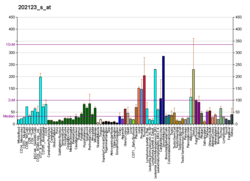Tyrosine-protein kinase ABL1 also known as ABL1 is a protein that, in humans, is encoded by the ABL1 gene (previous symbol ABL) located on chromosome 9.[5] c-Abl is sometimes used to refer to the version of the gene found within the mammalian genome, while v-Abl refers to the viral gene, which was initially isolated from the Abelson murine leukemia virus.[6]
Function edit
The ABL1 proto-oncogene encodes a cytoplasmic and nuclear protein tyrosine kinase that has been implicated in processes of cell differentiation, cell division, cell adhesion, and stress response such as DNA repair.[7][8][9][10] Activity of ABL1 protein is negatively regulated by its SH3 domain, and deletion of the SH3 domain turns ABL1 into an oncogene. The t(9;22) translocation results in the head-to-tail fusion of the BCR and ABL1 genes, leading to a fusion gene present in many cases of chronic myelogenous leukemia. The DNA-binding activity of the ubiquitously expressed ABL1 tyrosine kinase is regulated by CDC2-mediated phosphorylation, suggesting a cell cycle function for ABL1. The ABL1 gene is expressed as either a 6- or a 7-kb mRNA transcript, with alternatively spliced first exons spliced to the common exons 2–11.[11]
Clinical significance edit

Mutations in the ABL1 gene are associated with chronic myelogenous leukemia (CML). In CML, the gene is activated by being translocated within the BCR (breakpoint cluster region) gene on chromosome 22. This new fusion gene, BCR-ABL, encodes an unregulated, cytoplasm-targeted tyrosine kinase that allows the cells to proliferate without being regulated by cytokines. This, in turn, allows the cell to become cancerous.
This gene is a partner in a fusion gene with the BCR gene in the Philadelphia chromosome, a characteristic abnormality in chronic myelogenous leukemia (CML) and rarely in some other leukemia forms. The BCR-ABL transcript encodes a tyrosine kinase, which activates mediators of the cell cycle regulation system, leading to a clonal myeloproliferative disorder. The BCR-ABL protein can be inhibited by various small molecules. One such inhibitor is imatinib mesylate, which occupies the tyrosine kinase domain and inhibits BCR-ABL's influence on the cell cycle. Second generation BCR-ABL tyrosine-kinase inhibitors are also under developmentto inhibit BCR-ABL mutants resistant to imatinib.[12]
Interactions edit
ABL gene has been shown to interact with:
- ABI1,[13][14][15]
- ABI2,[16][17]
- ABL2,[16]
- ATM,[18][19][20]
- BCAR1,[21][22]
- BCR,[23][24][25]
- BRCA1,[26]
- CAT,[27]
- CBL,[28][29]
- CRKL,[30][31][32]
- DOK1,[33][34]
- EPHB2,[35]
- GPX1,[36]
- GRB10,[37][38]
- MTOR,[39]
- GRB2,[30][40]
- MDM2,[41]
- NCK1,[28][30]
- NEDD9,[42][43]
- NTRK1,[44][45]
- P73,[46][47]
- PAG1,[48]
- PAK2,[49]
- PSTPIP1,[50]
- RAD9A,[51]
- RAD51,[18]
- RB1,[52][53]
- RFX1,[54]
- RYBP,[55]
- SHC1,[23][56]
- SORBS2,[29][57]
- SPTA1,[58]
- SPTAN1,[58]
- TERF1,[20]
- VAV1,[59] and
- YTHDC1.[60]
Regulation edit
There is some evidence that the expression of Abl is regulated by the microRNA miR-203.[61]
See also edit
References edit
Further reading edit
- Shore SK, Tantravahi RV, Reddy EP (December 2002). "Transforming pathways activated by the v-Abl tyrosine kinase". Oncogene. 21 (56): 8568–76. doi:10.1038/sj.onc.1206084. PMID 12476303. S2CID 42502628.
- Shaul Y (2000). "c-Abl: activation and nuclear targets". Cell Death Differ. 7 (1): 10–6. doi:10.1038/sj.cdd.4400626. PMID 10713716.
- Era T (2002). "Bcr-Abl is a "molecular switch" for the decision for growth and differentiation in hematopoietic stem cells". Int. J. Hematol. 76 (1): 35–43. doi:10.1007/BF02982716. PMID 12138893. S2CID 10269867.
- Pendergast AM (2002). "The Abl family kinases: mechanisms of regulation and signaling". Advances in Cancer Research Volume 85. Vol. 85. pp. 51–100. doi:10.1016/S0065-230X(02)85003-5. ISBN 978-0-12-006685-8. PMID 12374288.
{{cite book}}:|journal=ignored (help) - Keung YK, Beaty M, Steward W, Jackle B, Pettnati M (2002). "Chronic myelocytic leukemia with eosinophilia, t(9;12)(q34;p13), and ETV6-ABL gene rearrangement: case report and review of the literature". Cancer Genet. Cytogenet. 138 (2): 139–42. doi:10.1016/S0165-4608(02)00609-X. PMID 12505259.
- Saglio G, Cilloni D (2004). "Abl: the prototype of oncogenic fusion proteins". Cell. Mol. Life Sci. 61 (23): 2897–911. doi:10.1007/s00018-004-4271-0. PMID 15583852. S2CID 35998018.
- Shaul Y, Ben-Yehoyada M (2005). "Role of c-Abl in the DNA damage stress response". Cell Res. 15 (1): 33–5. doi:10.1038/sj.cr.7290261. PMID 15686624.
- Yoshida K (2007). "Regulation for Nuclear Targeting of the Abl Tyrosine Kinase in Response to DNA Damage". Advances in Molecular Oncology. Advances in Experimental Medicine and Biology. Vol. 604. Springer. pp. 155–65. doi:10.1007/978-0-387-69116-9_15. ISBN 978-0-387-69114-5. PMID 17695727.
External links edit
- Genes,+abl at the U.S. National Library of Medicine Medical Subject Headings (MeSH)
- Online Mendelian Inheritance in Man (OMIM): 189980 (ABL)
- Abelson+Leukemia+Virus at the U.S. National Library of Medicine Medical Subject Headings (MeSH)
- Drosophila Abl tyrosine kinase - The Interactive Fly
- ABL1 Info with links in the Cell Migration Gateway
- ABL1 on the Atlas of Genetics and Oncology
- Human ABL1 genome location and ABL1 gene details page in the UCSC Genome Browser.
- Overview of all the structural information available in the PDB for UniProt: P00519 (Human Tyrosine-protein kinase ABL1) at the PDBe-KB.
- Overview of all the structural information available in the PDB for UniProt: P00520 (Mouse Tyrosine-protein kinase ABL1) at the PDBe-KB.





